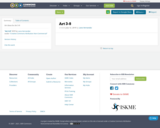
Art ideas for Art 3-8
- Subject:
- Arts and Humanities
- Material Type:
- Activity/Lab
- Date Added:
- 07/10/2019

Art ideas for Art 3-8
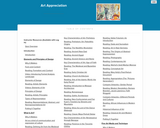
This course is particularly focused on helping you develop visual literacy skills, but all the college courses you take are to some degree about information literacy. Visual literacy is really just a specialized type of information literacy. The skills you acquire in this course will help you become an effective researcher in other fields, as well.
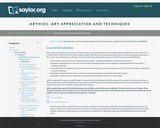
This course is an exploration of visual art forms and their cultural connections for the student with little experience in the visual arts. It includes a brief study of art history and in depth studies of the elements, media, and methods used in creative processes and thought. Upon successful completion of this course, students will be able to: interpret examples of visual art using a five-step critical process that includes description, analysis, context, meaning, and judgment; identify and describe the elements and principles of art; use analytical skills to connect formal attributes of art with their meaning and expression; explain the role and effect of the visual arts in societies, history, and other world cultures; articulate the political, social, cultural, and aesthetic themes and issues that artists examine in their work; identify the processes and materials involved in art and architectural production; utilize information to locate, evaluate, and communicate information about visual art in its various forms. Note that this course is an alternative to the Saylor FoundationĺÎĺ_ĺĚĺ_s ARTH101A and has been developed through a partnership with the Washington State Board for Community and Technical Colleges; the Saylor Foundation has modified some WSBCTC materials. This free course may be completed online at any time. (Art History 101B)
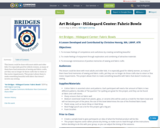
This lesson could be done with most adults and older kids. It is especially good for
elderly women, as many of them have fond memories of sewing and fabric crafts,
yet they can no longer do those crafts due to vision or fine motor impairments.
This project allows them to make something beautiful with fabric that doesn’t
involve any sewing.
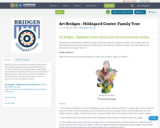
Family Tree (art and character studies)
Children have many family members and pets and friends who are “honorary” family. Have students discuss their family and describe how they look. This project can hold lots of different people. The child needs to put themselves at the top of the tree.
This lesson can also be used for character or historical figures studies.
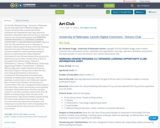
Art Club
By: Elizabeth Griggs - University of Nebraska-Lincoln Copyright 2018 by Elizabeth Griggs under Creative Commons Non-commercial License. Individuals and organizations may copy, reproduce, distribute, and perform this work and alter or remix this work for non-commercial purposes only
NEBRASKA HONORS PROGRAM CLC EXPANDED LEARNING OPPORTUNITY CLUBS INFORMATION SHEET:
Name of Club: Art Club
Age/Grade Level: K-5
Number of Attendees: (ideal number) 10
Goal of the Club: (learning objectives/outcomes) The goal of this art club is to introduce students to various painting techniques.
Resources: (Information for club provided by) Information for my club was obtained from my previous experience at an art studio.
Content Areas: (check all that apply)
☒ Arts (Visual, Music, Theater & Performance)
☐ Literacy
☐ STEM (Science, Technology, Engineering & Math)
☐ Social Studies
☐ Wellness (Physical Education, Health, Nutrition & Character Education)
Outputs or final products: (Does the club have a final product/project to showcase to community?) The final products included many paintings, including a grass landscape, watercolor paintings, an abstract piece and a Halloween inspired piece created by the attendees.
Introducing your Club/Activities: This club is designed for those students who enjoy being creative and learning various painting techniques.
General Directions: Have fun and allow students to use their creativity to paint works of art. Be flexible as students will put their own spin on the planned projects.
Tips/Tricks: Students enjoyed having free time to paint whatever they wanted. It is most successful when few instructions were given, and students got to decide what to add to the paintings. It is recommended that the club is carried out by two or more leaders.

This course examines how people learn, practice, and evaluate traditional and contemporary craft techniques. Social science theories of design, embodiment, apprenticeship learning, skill, labor, expertise, and tacit knowledge are used to explore distinctions and connections among art, craft, and science. We will also discuss the commoditization of craft into market goods, collectible art, and tourism industries. Ethnographic and historical case studies include textiles, glassblowing, quilting, cheese making, industrial design, home cooking, factory and laboratory work, CAD-CAM. In-class demonstrations and hands-on craft projects will be included.
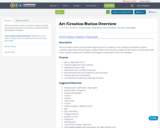
This is an overview of the art/creation station including the purpose, materials, questioning, considerations and photographic examples.

Art Interaction Mapping (AIM) is a creative brainstorming tool for advanced visual art projects. This framework was designed to help artists creatively integrate digital technologies with traditional mediums. These visualization models can be used to organize and structure ideas, refine concepts, or assess project outcomes.

ART BRIDGES: Lesson Plans for
Enrichment, Growth and Healing
Art Lesson Plans for a Joan Miro Drawing
Objectives:
• To introduce a famous Italian artist to the students.
• To teach the art element of “Line”
• To teach the art element of “Balance”
• To practice using these elements in creating a work of art
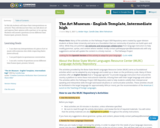
In this lab students will share their interpretations on artwork. They will discuss how they can talk about art and express their opinion with a partner or in a group. Students will answer questions across different time frames (past, present, future).
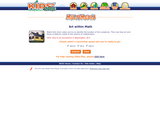
Watch this short video and try to identify the location of the sculptures. Then see how art and these sculptures relate to the science of mathematics.
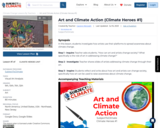
SYNOPSIS: In this lesson, students investigate how artists use their platforms to spread awareness about climate change.
SCIENTIST NOTES: This lesson encourages students to think about how artists and their art can be used to teach and inspire others about climate change. Many videos are included in the slideshow. Videos include one of Sarah Lewis, an art historian discussing how one person’s artwork can shift things, and a second one featuring “Earthrise,” a poem by Amanda Gorman, the youngest inaugural poet in U.S. history. There are an additional six videos covering artists and their artwork about climate change. This lesson finishes with great reflection questions and an opportunity for class discussion. This would be a great lesson for teaching the effects of art on the public perception of climate change.
POSITIVES:
-Students consider the role of art as a form of climate activism.
-Students are exposed to a variety of artists and types of art addressing climate change.
-This lesson has significant cross-curricular possibilities, even though it focuses on art and artists.
-Students begin to think about ways they might use artwork as a means of taking climate action.
ADDITIONAL PREREQUISITES:
-This is lesson 1 of 3 in our 9th-12th grade Climate Heroes unit.
-This lesson should follow a basic introduction to climate change science, exploration of global and local impacts, and climate change solutions.
-Some prior knowledge of contemporary art practices is useful, but not required.
DIFFERENTIATION:
-Teachers can provide instruction multimodally.
-Teachers can modify the assignment and assessment as needed.
-Teachers can follow up with questions to ensure comprehension.
-Teachers can pair students with helpful peers.

This resource is a video abstract of a research paper created by Research Square on behalf of its authors. It provides a synopsis that's easy to understand, and can be used to introduce the topics it covers to students, researchers, and the general public. The video's transcript is also provided in full, with a portion provided below for preview:
"Colorectal cancer (CRC) is one of the most common gastrointestinal malignancies, and 40% of cases are related to mutation of the oncogene KRAS. However, no KRAS-targeting drugs are currently available for cancer treatment, and patients with KRAS mutations are insensitive to anti-EGFR therapy, which is often used for CRC. To improve treatment options, a new study tested the combined effects of the drugs artesunate and WNT974 on KRAS-mutant CRC. In vitro, the combination synergistically reduced CRC growth and decreased KRAS protein levels and activity, while inducing KRAS degradation via the ubiquitin–proteasome pathway, thereby reducing the oncogene’s influence. Specifically, the induced KRAS degradation was mediated by upregulation of ANAPC2, as well as upregulation of β-TrCP and GSK-3β. In addition, the combination treatment suppressed the PI3K/Akt/mTOR pathway, which is downstream of KRAS and supports tumor growth..."
The rest of the transcript, along with a link to the research itself, is available on the resource itself.

Students learn how forces are used in the creation of art. They come to understand that it is not just bridge and airplane designers who are concerned about how forces interact with objects, but artists as well. As "paper engineers," students create their own mobiles and pop-up books, and identify and use the forces (air currents, gravity, hand movement) acting upon them.

Grade level: graduate students, advanced undergrads, persons with analyzed research results
Course length: 1 semester, 4-6 months
Objective: This course empowers scientists to engage with their own data, each other, and the public through art. Through collective brainstorming, prototyping, and feedback from professional artists, students will create a project that expresses their own research through any artistic medium of their choice. The course typically culminates in a public art exhibition where students interact with a general audience to discuss their research, art, and what it means to be a scientist.
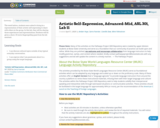
The week before, students were asked to bring in a representation of their artistic self-expressing to share with others in the group. In this lab, they will be sharing those experiences and representations. Students will be given a short, 10 word, fingerspelling quiz from the lab assistant.
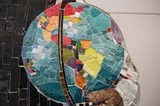
This unit explores the various ways information and ideas about climate change are presented through a variety of media. This includes the evaluation of social media posts, research into climate change issues, and an exploration of contemporary art and artists. This was designed and taught in an honors 9th grade English Language Arts Classroom by Dr. Tavia Quaid in response to student interest in climate change and to reinforce key information literacy skills.

This unit explores the various ways information and ideas about climate change are presented through a variety of media. This includes the evaluation of social media posts, research into climate change issues, and an exploration of contemporary art and artists.
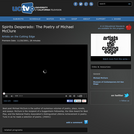
Beat poet Michael McClure is the author of numerous volumes of poetry, plays, novels, and essays. McClure is the recipient of a Guggenheim Fellowship, the Obie Award for Best Play, and the National Poetry Association's Distinguished Lifetime Achievement in poetry. Tune in as he reads a selection of poems. (28 minutes)